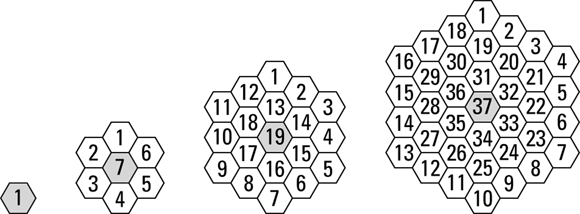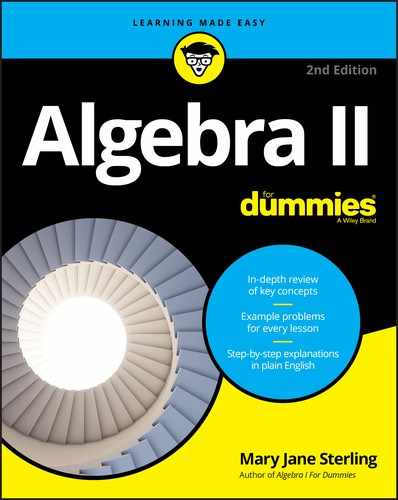Chapter 19
Ten Special Types of Numbers
IN THIS CHAPTER
![]() Associating numbers with shapes
Associating numbers with shapes
![]() Characterizing numbers as perfect, narcissistic, and so on
Characterizing numbers as perfect, narcissistic, and so on
Mathematicians classify numbers in many ways, much like psychologists (and gossipers) classify people: even or odd, positive or negative, rational or irrational, and so on. In this chapter, I show you even more ways to pigeonhole numbers by putting them into interesting groupings that make them special.
Triangular Numbers
Triangular numbers are numbers in the sequence 1, 3, 6, 10, 15, 21, 28, and so on (for more on sequences, see Chapter 16). You may have noticed that each term in the sequence is larger than the previous number by one more value than the previous difference between the terms. Say what? Okay, let me put that another way: To find the second term, you add 2 to the previous term. To find the third term, you add 3; add 4 for the fourth term, 5 for the fifth, and so on.
The formula for finding the nth triangular number is ![]() . Here’s how you use the formula to find the eighth triangular number (one more than the number 28 in the previous list):
. Here’s how you use the formula to find the eighth triangular number (one more than the number 28 in the previous list): ![]() . The number 36 is 8 more than the number 28, which is 7 more than 21, and so on. You can also depict the triangular numbers by counting the connected dots in triangular arrays:
. The number 36 is 8 more than the number 28, which is 7 more than 21, and so on. You can also depict the triangular numbers by counting the connected dots in triangular arrays:

Square Numbers
The squares of numbers should be familiar to you: 1, 4, 9, 16, 25, 36, and so on. As the following figure shows, connected dots in arrays can illustrate squared numbers. Perfect squares, ![]() , show up in algebra and geometry all the time. You see the squares when you’re working with quadratic equations (Chapter 3) and the conics (Chapter 11). In geometry, Pythagoras was dependent on squares to do his famous Pythagorean Theorem (the sum of the squares of the two shorter sides of a right triangle is equal to the square of the longest side).
, show up in algebra and geometry all the time. You see the squares when you’re working with quadratic equations (Chapter 3) and the conics (Chapter 11). In geometry, Pythagoras was dependent on squares to do his famous Pythagorean Theorem (the sum of the squares of the two shorter sides of a right triangle is equal to the square of the longest side).

Hexagonal Numbers
Hexagonal numbers appear in the sequence 1, 7, 19, 37, 61, 91, and so on. You can illustrate these numbers by drawing hexagons, and then hexagons around the hexagons, and so on; you then count how many hexagons you have, as you see here:

Another way you can list hexagonal numbers, if you’re not into drawing all the six-sided figures, is to use the formula for the nth hexagonal number: ![]() or
or ![]() . You may have noticed from the pattern that you create the next hexagonal number in the sequence by adding six to the previous difference (7 to 19 is 12, and 19 to 37 is 18, for example). The numbers can get pretty large pretty quickly, though, so the formula helps. You can use this formula to find the tenth hexagonal number, for example:
. You may have noticed from the pattern that you create the next hexagonal number in the sequence by adding six to the previous difference (7 to 19 is 12, and 19 to 37 is 18, for example). The numbers can get pretty large pretty quickly, though, so the formula helps. You can use this formula to find the tenth hexagonal number, for example: ![]() .
.
Perfect Numbers
A perfect number is a number in which the sum of its proper divisors (numbers smaller than the number in question that divide it evenly) is equal to that number. For instance, the number 6 is a perfect number, because ![]() . The next few perfect numbers are
. The next few perfect numbers are ![]() ,
, ![]() , and 8,128. Notice how these proper divisors all have “pairs,” except for the 1. The pairs multiply together to give you the number in question: 2 times 14, 4 times 7 in the case of the 28. Can you find all the proper divisors of 8,128? Have fun! There’s no magic formula for finding these numbers. Just get out your calculator!
, and 8,128. Notice how these proper divisors all have “pairs,” except for the 1. The pairs multiply together to give you the number in question: 2 times 14, 4 times 7 in the case of the 28. Can you find all the proper divisors of 8,128? Have fun! There’s no magic formula for finding these numbers. Just get out your calculator!
Amicable Numbers
Two numbers are amicable if each value is equal to the sum of the proper divisors of the other. The numbers 284 and 220 are amicable, for example, because the sum of the proper divisors of 284 is ![]() , and the sum of the proper divisors of 220 is
, and the sum of the proper divisors of 220 is ![]() . Other sets of amicable numbers include the pair 1,184 and 1,210 and the pair 17,296 and 18,416. Do you want to find more amicable numbers? Go for it, but don’t expect a magic formula to help you.
. Other sets of amicable numbers include the pair 1,184 and 1,210 and the pair 17,296 and 18,416. Do you want to find more amicable numbers? Go for it, but don’t expect a magic formula to help you.
Happy Numbers
A number is considered happy if the sum of the squares of its digits, or the sum of the squares of the sum of its squares, is equal to one.
For instance, the number 203 is happy because the sum of the squares of its digits is ![]() ; the sum of the squares of the digits in 13 is
; the sum of the squares of the digits in 13 is ![]() ; and the sum of the squares of the digits in 10 is
; and the sum of the squares of the digits in 10 is ![]() . Finally! You may be surprised to find that a bigger number such as 2,211 is happy in fewer steps! You take
. Finally! You may be surprised to find that a bigger number such as 2,211 is happy in fewer steps! You take ![]() , and
, and ![]() .
.
Abundant Numbers
An abundant number is a number with one rule: The sum of its divisors must be greater than twice the number. For instance, the number 12 is abundant because ![]() , and 28 is greater than twice 12. Some other abundant numbers include 18, 20, 24, 30, 36, and 100.
, and 28 is greater than twice 12. Some other abundant numbers include 18, 20, 24, 30, 36, and 100.
Deficient Numbers
A deficient number has almost the opposite rule of an abundant number (see the previous section). If the sum of the proper divisors of a number is less than the original number, the number is a deficient number. An example of a deficient number is 15, because the sum of its proper divisors is ![]() , and 9 is less than 15. What about the number 32? Is it deficient? The sum of its proper divisors is
, and 9 is less than 15. What about the number 32? Is it deficient? The sum of its proper divisors is ![]() , so 32 is also deficient.
, so 32 is also deficient.
Narcissistic Numbers
A narcissistic number is a number that you can write by using operations involving all the digits in the number. For instance, the number 371 is narcissistic because if you take the digits — 3, 7 and 1 — raise each to the third power, and add the powers together, you get the original number: ![]() . The digits of the number look in the mirror with operations, so to speak, and see only themselves. Another narcissistic number is 2,427, because you can raise the digits to successively larger powers, add up the powers, and get the original number:
. The digits of the number look in the mirror with operations, so to speak, and see only themselves. Another narcissistic number is 2,427, because you can raise the digits to successively larger powers, add up the powers, and get the original number: ![]() . The possibilities for self-absorbed numbers are endless.
. The possibilities for self-absorbed numbers are endless.
Prime Numbers
A prime number is divisible only by the number 1 and itself. The first 15 prime numbers are as follows: 2, 3, 5, 7, 11, 13, 17, 19, 23, 29, 31, 37, 41, 43, and 47. Even though mathematicians have been working on prime numbers for centuries, they haven’t found a formula or pattern that finds or predicts all the prime numbers.
A famous conjecture (mathematicians haven’t proven a conjecture, but they haven’t disproved it either) involving prime numbers is Goldbach’s Conjecture. Goldbach theorized that you can write every even number greater than two as the sum of two primes. For instance, ![]() ,
, ![]() , and so on.
, and so on.
People armed with powerful computers and lots of computing time are always coming up with new prime numbers, but it doesn’t happen too frequently. If you’re interested in trying to make some money from finding a prime number, look up Mersenne Primes on the Internet. There’s a big money bounty on finding the next Mersenne Prime (a prime that’s one less than the number two raised to a prime power). For example, a walloping $3,000 was awarded to a Missouri researcher for finding the 48th known Mersenne prime. The number is 17,425,170 digits long.
